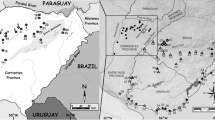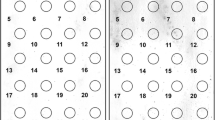Abstract
Chromosomes from several species of ants from the genus Myrmecia were hybridized with deoxyoligomer probes of either (T2AG2)7, the putative insect telomere repeat sequence, or (T2AG3)7, the vertebrate telomere repeat sequence. While both sequence hibridized over a range of stringency conditions, (T2AG2)n was clearly the predominant sequence at the termini of the Myrmecia chromosomes. No interstitial sites of either sequence were detected. The genus Myrmecia has a wide range of karyotypes, with chromosome numbers ranging from 2n=2–84. It has been hypothesized that the ancestral karyotype was 2n=4 and karyotype evolution proceeded with an increase in chromosome number. In the absence of detectable interstitial sites of telomere sequence, it is interesting to speculate on the origin of the new telomeres as the chromosome numbers increased.
Similar content being viewed by others
References
Allshire RC, Dempster M, Hastie ND (1989) Human telomeres contain at least three types of G-rich repeat distributed nonrandomly. Nucleic Acids Res 17: 4611–4627
Contreras LC, Torres-Mura JC, Spotorno AE (1990) The largest known chromosome number for a mammal in a South American desert rodent. Experientia 46: 506–508
Crosland MWJ, Crozier RH (1986) Myrmecia pilosula, an ant with only one pair of chromosomes. Science 231: 1278
Hirai H, Spotila LD, LoVerde PT (1989) Schistosoma mansoni: chromosomal localization of DNA repeat elements by in situ hybridization using biotinylated DNA probes. Exp Parasitol 69: 175–188
Imai HT, Taylor RW (1989) Chromosomal polymorphisms involving telomere fusion, centrolmeric inactivation and centromere shift in the ant Myrmecia (pilosula) n=1. Chromosoma 98: 456–460
Imai HT, Crozier RH, Taylor RW (1977) Karyotype evolution in Australian ants. Chromosoma 59: 341–393
Imai HT, Taylor RW, Crosland MWJ, Crozier RH (1988) Modes of spontaneous chromosomal mutation and karyotype evolution in ants with reference to the minimum interaction hypothesis. Jpn J Genet 63: 159–185
Imai HT, Taylor RW, Kubota M, Ogata K, Wada MY (1990) Notes on the remarkable karyology of the primitive ant Northomyrmecia macrops, and of the related genus Myrmecia (Hymenoptera: Formicidae). Psyche 97: 133–140
Imai HT, Taylor RW, Crozier RH (1994) Experimental bases for the minimum interaction theory. I. Chromosome evolution in ants of the Myrmecia pilosula species complex (Hymenoptera: Formicidae: Myrmeciinae). Jpn J Genet 69: 137–182
Mason JM, Biessmann H (1995) The unusual telomeres of Drosophila. Trends Genet 11: 58–62
Matthey R (1973) The chromosome formulae of eutherian antimals. In: Chiarelli AB, Capanna E (eds) Cytotaxonomy and vertebrate evolution. Academic Press, London, pp 531–616
Meyne J, Moyzis RK (1989) Human chromosome-specific repetitive DNA probes: targeting in situ hybridization to chromosome 17 with a 42 base pair alphoid DNA oligomer. Genomics 4: 472–478
Meyne J, Ratliff RL, Moyzis RK (1989) Conservation of the human telomere sequence (TTAGGG)n. Proc Natl Acad Sci USA 86: 7049–7053
Moyzis RK, Buckingham JM, Cram LS, Dani M, Deaven LL, Jones MD, Meyne J, Ratliff RL, Wu J-R (1988) A highly conserved repetitive DNA sequence (TTAGGG)n, present at the telomeres of human chromosomes. Proc Natl Acad Sci USA 85: 6622–6626
Okazaki S, Tsuichida K, Maekawa H, Ishikawa H, Fujiwara H (1993) Identification of a pentanucleotide telomeric sequence, (TTAGG)n, in the silkworm Bombyx mori and in other insects. Mol Cell Biol 13: 1424–1432
Weber B, Collins C, Robbins C, Magenis RE, Delaney AD, Gray JW, Hayden MR (1990) Characterization and organization of DNA sequence adjacent to the human telomere associated repeat (TTAGGG)n. Nucleic Acids Res 18: 3353–3361
Zakian VA (1989) Structure and function of telomeres. Annu Rev Genet 23: 579–604
Author information
Authors and Affiliations
Rights and permissions
About this article
Cite this article
Meyne, J., Hirai, H. & Imai, H.T. FISH analysis of the telomere sequences of bulldog ants (Myrmecia: Formicidae). Chromosoma 104, 14–18 (1995). https://doi.org/10.1007/BF00352221
Received:
Accepted:
Issue Date:
DOI: https://doi.org/10.1007/BF00352221




